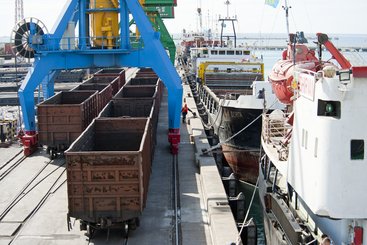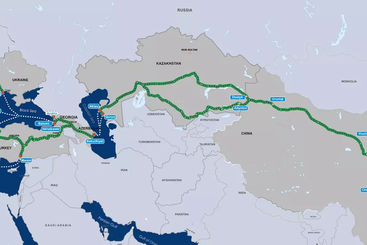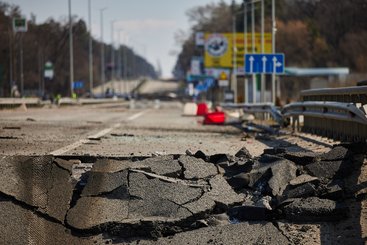The Middle Corridor – also known as the Trans-Caspian International Transport Route – is a multimodal trade corridor and network of road, rail and ferry routes linking China to Europe. The Corridor, which runs across Central Asia, Turkey, the South Caucasus, and the Caspian Sea is seen as a means to diversify trade routes, enhance connectivity and decrease reliance on Russia in light of the Russia-Ukraine war.
Beyond infrastructure and practical concerns, there are broader geopolitical risks to consider when discussing the Middle Corridor. While optimism for a trade route bypassing Russia is warranted in the region and among various Western capitals, certain geopolitical challenges remain, and glossing over these challenges may lead to an overly optimistic representation on the future trajectory of the Corridor.
Battle of the corridors
An issue of concern regarding the Corridor’s development is competing alternative trade corridors passing through the region. The International North-South Transport Corridor (INSTC) is a similar multimodal transportation network connecting the Indian Ocean and the Persian Gulf with the Caspian Sea and then on to Europe, which aims to increase trade and economic cooperation among participating countries. This alternative Corridor also allows for shorter trading times for Iran, India, and Russia when compared to the Middle Corridor. In contrast to the Middle Corridor, the INSTC is backed by Iran and Russia.
Given its geostrategic position, India assumes a significant role in this route, serving as a vital southern access point for the INSTC. India views the INSTC as a means to strengthen its relations with Central Asia and the South Caucasus and extend its global trade reach. From Tehran’s standpoint, the route represents an opportunity for economic diversification and entry into new markets, serving as a means to avoid economic isolation from sanctions. Iran’s participation in the INSTC helps the country to further consolidate its foothold in Central Asia, a region which has been a long-term foreign priority for Iran.
The concurrent development of the INSTC has the potential to overshadow advancements made along the Middle Corridor. Specifically, the INSTC route may emerge as a more cost-effective alternative for the participating countries, posing a risk to continued progress and future investments into the Middle Corridor. Consequently, the INSTC presents a challenge to the development of the Middle Corridor as it has the potential for a more competitive offer aligned with the strategic interests of the countries and businesses involved, especially when considering that these nations are still deliberating the extent of their commitment to the development of the Middle Corridor.
All participants benefit, though the extent of benefit varies
In many of the discussions on the Middle Corridor, attention is typically directed toward trade and economic opportunities. However, this assessment fails to capture the competing interests in the Corridor’s advancement. Turkey is keen to promote the Middle Corridor to bolster economic ties with Central Asia and provide a compelling trade route, strongly advocated by Ankara. Last December in Baku, Turkish Foreign Minister, Hakan Fidan, stated that ‘enhancing the Middle Corridor to its maximum potential is crucial’; and that ‘the development of the region depends critically on increasing the number of such projects’.
Beijing has also expressed interest in the development of the Middle Corridor, particularly within the framework of the Belt and Road Initiative (BRI). Closer links with both Central Asia and the South Caucasus enables China to enhance connectivity for trade and economic growth with Europe, which also improves the security and reliability of China’s trade connections. Development of the
Corridor also provides opportunities for China to invest in infrastructure development, including the construction of roads, ports and railways – all of which are critical to the Middle Corridor.
Both Ankara and Beijing, leading advocates of the initiative, are actively investing in the development of the Middle Corridor, driven by their own respective strategic interests. China views the progress of the Middle Corridor through the prism of its own BRI, resulting in substantial investment into infrastructure, while Turkey sees the Corridor’s development as aligning with its foreign policy objectives. Although there isn’t an immediate risk of diverging interests, there exists the potential for friction between both nations regarding the future development the Middle Corridor. This consideration becomes particularly significant in light of their respective long-term aspirations to reap increased benefits from the Corridor’s success. It is important to take into account when discussing the Corridor’s future prospects that some countries are poised to gain more than others and the issue of varying gains should be considered in discussions regarding the Middle Corridor’s trajectory.
The advancement of the Middle Corridor signals positive prospects for regional cooperation. Nonetheless, it is important to acknowledge potential risks, such as competition from other corridors and the varying gains among participating countries, which are often overlooked in discussions about the Corridor’s future. The impact of these factors on the Corridor’s progress will mostly hinge on the level of further commitment expressed from participating countries. At the same time, it is essential not to underestimate the evolution of the Middle Corridor amid the evolving geopolitical landscape shaped by the Russia-Ukraine war and the extent to which external interests influence the Corridor’s advancement.



